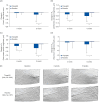Liquid collagen from freshwater fish skin ameliorates hydration, roughness and elasticity in photo-aged skin: a randomized, controlled, clinical study
- PMID: 38854476
- PMCID: PMC11156766
- DOI: 10.4162/nrp.2024.18.3.357
Liquid collagen from freshwater fish skin ameliorates hydration, roughness and elasticity in photo-aged skin: a randomized, controlled, clinical study
Abstract
Background/objectives: Collagen is commonly used in diverse forms as a functional component in skincare products. On the other hand, the effects of collagen on human skin are controversial. Dietary collagen hydrolysates from freshwater Pangasius hypophthalmus fish skin ameliorated photo-aged skin of hairless mice. This study conducted a randomized, double-blind, placebo-controlled clinical trial to determine if liquid fish collagen (Collagen-Tripep20™, Tripep20) as a drink strengthens skin health and quality.
Subjects/methods: In this clinical trial, 85 subjects aged 35-60 yrs were diagnosed with photo-aged skin. Eighty-five subjects were randomized to receive either Tripep20 (n = 44) or placebo (n = 41). Seventy-eight subjects fully participating for a 12-week period consumed 1,000 mg of Tripep20 (n = 41) or placebo (n = 37) in a 50-mL bottle as a daily drink. The intend-to-treat and per-protocol populations were 85 and 78, respectively. Skin hydration, wrinkles, and elasticity were assessed at 0 (baseline), 6, and 12 weeks during the study period.
Results: Skin hydration in the Tripep20 group was significantly higher from 6 weeks (P < 0.001) than the baseline. After 12 weeks, the Crow's-feet visual score and skin roughness (Ra, Rq, and Rmax) were significantly improved in the Tripep20 group than in the placebo group (P < 0.05). Consuming liquid collagen Tripep20 greatly enhanced skin elasticity (Gross R2, Net R5, and Biological elasticity R7) in 6 weeks compared to the placebo group. The Tripep20 group showed a significant increase in skin elasticity from the baseline after 6 and 12 weeks (P < 0.001). Neither abnormal symptoms nor adverse events were encountered during the study period in subjects ingesting Tripep20 or placebo. The changes in parameters related to hematology and clinical chemistry were within the normal ranges.
Conclusion: Oral consumption of liquid collagen Tripep20 was safe and well-tolerated. The results of this study show that freshwater fish-derived liquid collagen Tripep20 can be used as a healthy functional food ingredient to improve skin moisturizing, anti-wrinkling, and elasticity in an aging population.
Keywords: Collagen; clinical trial; elasticity; fresh water; skin aging.
©2024 The Korean Nutrition Society and the Korean Society of Community Nutrition.
Conflict of interest statement
Conflict of Interest: JSL, YCY, JMK, YHK, and YCS were employed by Amicogen Inc. The authors declare that this study was fully supported from Amicogen Inc. The funder had the following involvement in the study: study design.
Figures




Similar articles
-
Oral Intake of Low-Molecular-Weight Collagen Peptide Improves Hydration, Elasticity, and Wrinkling in Human Skin: A Randomized, Double-Blind, Placebo-Controlled Study.Nutrients. 2018 Jun 26;10(7):826. doi: 10.3390/nu10070826. Nutrients. 2018. PMID: 29949889 Free PMC article. Clinical Trial.
-
Oral Supplementation of Low-Molecular-Weight Collagen Peptides Reduces Skin Wrinkles and Improves Biophysical Properties of Skin: A Randomized, Double-Blinded, Placebo-Controlled Study.J Med Food. 2022 Dec;25(12):1146-1154. doi: 10.1089/jmf.2022.K.0097. J Med Food. 2022. PMID: 36516059 Clinical Trial.
-
Oral Intake of Hydrangea serrata (Thunb.) Ser. Leaves Extract Improves Wrinkles, Hydration, Elasticity, Texture, and Roughness in Human Skin: A Randomized, Double-Blind, Placebo-Controlled Study.Nutrients. 2020 May 28;12(6):1588. doi: 10.3390/nu12061588. Nutrients. 2020. PMID: 32481760 Free PMC article. Clinical Trial.
-
Oral Collagen Supplementation: A Systematic Review of Dermatological Applications.J Drugs Dermatol. 2019 Jan 1;18(1):9-16. J Drugs Dermatol. 2019. PMID: 30681787
-
Exploring the Impact of Hydrolyzed Collagen Oral Supplementation on Skin Rejuvenation: A Systematic Review and Meta-Analysis.Cureus. 2023 Dec 9;15(12):e50231. doi: 10.7759/cureus.50231. eCollection 2023 Dec. Cureus. 2023. PMID: 38192916 Free PMC article. Review.
References
-
- Kelly RI, Pearse R, Bull RH, Leveque JL, de Rigal J, Mortimer PS. The effects of aging on the cutaneous microvasculature. J Am Acad Dermatol. 1995;33:749–756. - PubMed
-
- Chung JH, Yano K, Lee MK, Youn CS, Seo JY, Kim KH, Cho KH, Eun HC, Detmar M. Differential effects of photoaging vs intrinsic aging on the vascularization of human skin. Arch Dermatol. 2002;138:1437–1442. - PubMed
-
- Ichihashi M, Ando H, Yoshida M, Niki Y, Matsui M. Photoaging of the skin. Anti-aging Medicine. 2009;6:46–59.

